|
|
|
Sort Order |
|
|
|
Items / Page
|
|
|
|
|
|
|
| Srl | Item |
| 1 |
ID:
113896
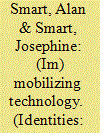

|
|
|
|
|
| Publication |
2011.
|
| Summary/Abstract |
Immobilization is generally thought to result from power and poverty acting against the acceleration produced by science and technology. In this article we explore neglected countervailing trends, such as quarantines, health inspections, and import bans, where science has the effect of restricting mobility, which we refer to as "slow science." As well as increasing mobility, science can be mobilized for political projects of restricting movement, but this possibility is neglected because of cultural assumptions fundamental to modernity. Both science and technology can be enrolled for projects of slowing mobility as well as increasing mobility. Drawing on actor-network theory, we examine the enrolment of science and technology into restricting movement in various ways. These issues are explored first through an overview of the neglected genealogy of the ways in which science and technology have slowed movement, particularly across national borders, and second through a short case study of how food safety concerns affect the movement of beef across borders. The case study discusses how "slow science" diagnoses threats posed by mobility and develops technologies to immobilize certain entities. These entities have almost always been biological organisms (including humans) or their products due to the self-reproducing qualities of invasive species, bacteria, or viruses. Uniquely, WTO rules about food require that restrictions be based on sound science, resulting in trade disputes focused on scientific interpretations.
|
|
|
|
|
|
|
|
|
|
|
|
|
|
|
|
| 2 |
ID:
194296


|
|
|
|
|
| Summary/Abstract |
Current outcomes of immigration enforcement policies and apparatuses call for rethinking the ethics behind our understanding of community belonging, human rights and just society. The ethics at work are often presented as emotions creating particular affective atmosphere that permit the ongoing implementation of enforcing migration. This Special Issue tackles emotions as processes of organizing that are mobilized in support of certain ethics. In the context of immigration enforcement, these emotions are not self-explanatory, but they can justify the potential for violence and even deem it necessary. The emotions or affects of enforcers (as opposed to migrants) have been less addressed, and this Special Issue aims to be a novel collection. The articles pay particular attention to racism and to the understanding of institutional racism within state structures. They reveal the ways in which emotions are instrumental to the operations of state bureaucracy within the repressive migration apparatus and point to the ethics that allows individuals to conform state structures of oppression.
|
|
|
|
|
|
|
|
|
|
|
|
|
|
|
|
| 3 |
ID:
195678


|
|
|
|
|
| Summary/Abstract |
Migration scholarship has thus far largely neglected the role of aircraft in both (irregular) migration and state policies aimed at controlling migration. Drawing inspiration from the field of strategic studies, where ‘airpower’ has been a key theoretical concept, this article explores the role of aerial assets in states’ migration control efforts. The article discusses three main dimensions of the use of airpower in controlling migration: the increasing resort to aircraft for border enforcement purposes – or what can be referred to as ‘vertical border policing’ –, states’ tight monitoring of the aerial migration infrastructure, and the use of aircraft in migrant return operations. As a core element of state power, it is airpower’s key features of reach, speed and height which have made it a particularly useful migration control instrument.
|
|
|
|
|
|
|
|
|
|
|
|
|
|
|
|
| 4 |
ID:
153010
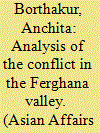

|
|
|
|
|
| Summary/Abstract |
The Ferghana valley which is an ethnically and culturally complex region divided among three Central Asian Republics of Kyrgyzstan, Tajikistan and Uzbekistan, witnessed a number of problems ranging from inter- ethnic tensions to border incursions; from security related complications to a number of socio- economic difficulties in the recent years. Moreover, it is also the most densely populated areas in Central Asia. Though sometimes the threat of religious extremism and intolerance in the Ferghana valley has been exaggerated yet it is difficult to completely deny their presence in the region and the obvious threat it has been posing for the entire Central Asia in future. The artificial delineation of border in the Ferghana valley which was finalized during the soviet era can be considered as one of the principle reasons behind the occurrences of various conflicts in the valley especially after the disintegration of the Soviet Union. Similarly, economy also plays a pivotal role in accentuating the conflict in the region as it is found that the root cause of majority of the conflicts prevalent in the region are regarding the domination of a particular ethnic group on the economic resources of that very area. However, the rivalry between the elites of the three republics and their struggle for power also play a prominent role in the disturbances that has been taking place in Ferghana valley as the elites of the valley do not want to lose their predominant position in the newly formed political establishments of their respective republics.
|
|
|
|
|
|
|
|
|
|
|
|
|
|
|
|
| 5 |
ID:
186196
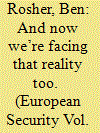

|
|
|
|
|
| Summary/Abstract |
Though conspicuous by its absence in debates among the British political and media establishments during the EU referendum campaign, the Irish border has been the central feature of Brexit as the implications and complications of trying to “take back control of borders” have become apparent. Drawing on focus group data gathered between 2017 and 2019 I employ ontological security theory to investigate the impact that Brexit is having on residents and communities living in the central Irish border region. In particular, I draw on the work of David Carr to explore the social role of memory and narrative in ontological (in)security and how this has manifested in the border region throughout the Brexit process. I find that the uncertainties generated by Brexit have caused border residents to draw on anxiety-filled memories and narratives from the securitised border of the pre-Good Friday Agreement era which they then project onto and vicariously through the next generation who, in turn, embody these anxieties, creating intergenerational ontological insecurity. Brexit has reintroduced, if not the physical border, the psychological borders of the past.
|
|
|
|
|
|
|
|
|
|
|
|
|
|
|
|
| 6 |
ID:
153870
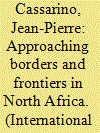

|
|
|
|
|
| Summary/Abstract |
Recent policy developments in the western Mediterranean, especially in North Africa, pose an important puzzle for our understanding of borders and frontiers and the ways in which they are politically addressed. This article sets out to analyse their various implications for patterns of interdependence among states, territoriality, sovereignty, mobility, and last but not least, for domestic politics. By drawing on a vast corpus, the study provides a broader interpretation of such implications which, as argued, cannot be captured with exclusive reference to securitization and processes of demarcation. This endeavour is important to explore how the power dimension in the borderland may interact with other dimensions of the border. Each disciplinary approach discussed in this study, including its heuristic devices, provides a valid explanation of the oft-cited disconnect that scholars have observed in North Africa between the territorially bounded ideal-type of the nation-state and the ways in which it is concretely translated, if not reinterpreted, by borderlanders. An important insight is to venture far beyond disciplinary dogmatism with a view to addressing an array of drivers (be they political, historical, social, economic and geostrategic) that propels bordering practices in North Africa and determines, by the same token, their effects on the ground.
|
|
|
|
|
|
|
|
|
|
|
|
|
|
|
|
| 7 |
ID:
140052
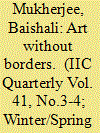

|
|
|
| 8 |
ID:
141539
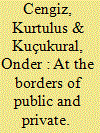

|
|
|
|
|
| Summary/Abstract |
This article examines the political implications of the vibrant social life of the city of Kayseri in Turkey. By using qualitative data collected by participant observations and in-depth interviews, we discuss the traditional form of gatherings called oturmalar. We evaluate the lively participation in public gatherings whose borders blur public, private, and religious fields in the light of more theoretical debates on the public sphere and situated within the literature on the public sphere in the Middle East.
|
|
|
|
|
|
|
|
|
|
|
|
|
|
|
|
| 9 |
ID:
171170
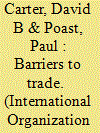

|
|
|
|
|
| Summary/Abstract |
Since trade must cross borders, to what extent do border walls affect trade flows? We argue that border walls can reduce trade flows. Even if the objective is to only stem illicit flows, border walls heighten “border effects” that can also inhibit legal cross-border flows. Using a gravity model of trade that reflects recent developments in both economic theory and econometrics, we find that the creation of a wall is associated with a reduction in legal trade flows between neighboring countries. We provide a battery of evidence that suggests this reduction is not simply a function of worsening bilateral relations. Our findings have implications for understanding how governments have taken measures to assert sovereign control of their borders in an age of increasing economic globalization.
|
|
|
|
|
|
|
|
|
|
|
|
|
|
|
|
| 10 |
ID:
147882


|
|
|
|
|
| Summary/Abstract |
This article analyzes spatial perceptions and practices of Druze citizens of Israel before, during, and after the Israeli occupation of South Lebanon in 1982−2000. It argues that the opening of the Israel–Lebanon border in 1982 and its closing in 2000 had three effects: it generated internal social, political, and cultural changes within the community in Israel; it changed the relationship of the Druze with the State of Israel; and it reestablished strong ties with their coreligionists in Lebanon and Syria. Drawing insight from the field of border studies, the article shows how Druze citizens of Israel live concomitantly in state and suprastate spatial scales, forming a third, integrated or hybrid, spatial scale. The article proposes using the concept “hybrid spatial scale” as a tool for studying communities such as the Druze that operate on multiple territorial scales.
|
|
|
|
|
|
|
|
|
|
|
|
|
|
|
|
| 11 |
ID:
100047
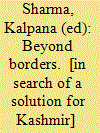

|
|
|
|
|
| Publication |
New Delhi, Centre for Dialogue and reconciliation, 2009.
|
| Description |
98p.
|
|
|
|
|
|
|
|
|
|
|
|
Copies: C:1/I:0,R:0,Q:0
Circulation
| Accession# | Call# | Current Location | Status | Policy | Location |
| 055481 | 303.609546/SHA 055481 | Main | On Shelf | General | |
|
|
|
|
| 12 |
ID:
197017


|
|
|
|
|
| Summary/Abstract |
Our ethnographic fieldwork with Congolese and Zimbabwean economic migrants, asylum seekers, refugees and educational migrants reveals a complex narrative of exclusion and inclusion in South Africa. Frontier Africans – South African citizens and African transmigrants alike – initiate and maintain connections that create a vexing and entangled narrative of hard and soft borders. A deeper consideration of how South African citizens and African transmigrants subvert and transcend state-centric categorisation of citizen and migrant other, through amity, conviviality and mutuality – a process of humaning – harasses the alignment of political categorisation with analytical elucidation.
|
|
|
|
|
|
|
|
|
|
|
|
|
|
|
|
| 13 |
ID:
116187
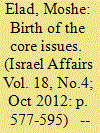

|
|
|
|
|
| Publication |
2012.
|
| Summary/Abstract |
In the past two decades the Israeli-Palestinian conflict has been identified with the dispute over four core issues: the future of East Jerusalem, the Jewish settlements in the disputed territories, the final borders between the two sides, and the fate of the Palestinian refugees. The first three issues were born during the first 10 years of Israel's control of the West Bank and East Jerusalem, while the refugee problem dates back to the 1948 war. Yet it was the Israeli administration from 1967 to 1976 that exposed the refugee camps to the Israeli public and led to initial efforts to resolve this problem. This first half of the two-part article outlines the establishment of the Israeli administration in the West Bank and East Jerusalem and lays the ground for the creation of the core issues which will be described in the second part.
|
|
|
|
|
|
|
|
|
|
|
|
|
|
|
|
| 14 |
ID:
127938
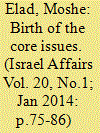

|
|
|
|
|
| Publication |
2014.
|
| Summary/Abstract |
In the last two decades, the Israeli-Palestinian conflict has been highly identified with the dispute over the core issues: Israel's annexation of East Jerusalem, the establishment of settlements in the disputed territories, the final borders between the two parties and the Palestinian refugee problem. The first three issues were a result of the 1967 war, while the refugee problem was a corollary of the 1948 war. However, it was the Israeli administration from 1967 to 1976 that exposed refugee camps to the Israeli public and made some initial efforts to resolve the problem.
|
|
|
|
|
|
|
|
|
|
|
|
|
|
|
|
| 15 |
ID:
190919
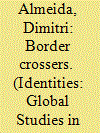

|
|
|
|
|
| Summary/Abstract |
Intra-urban borders are a pervasive feature in today’s global cities. They are not only the result of urban planning but they are also reproduced in everyday movements and interactions. Based on interviews and participant observation in French banlieues of Greater Paris, Mulhouse and Strasbourg, I analyse how inhabitants narrate movements in urban space that lead them to cross the boundaries of their neighbourhood. I build upon Lefebvre’s notion of spatial practice and insights from border studies to understand how these movements relate to the social production of urban marginality. The findings show how experiences and representations of intra-urban border-crossing among banlieue residents are shaped by and reproduce geographies of exclusion.
|
|
|
|
|
|
|
|
|
|
|
|
|
|
|
|
| 16 |
ID:
153869
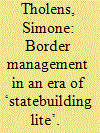

|
|
|
|
|
| Summary/Abstract |
International border management strategies have become the favoured practice to counter global threats, notably terrorism, migration flows and ‘weak states’. This article shows how border security assistance is translated and has political consequences in contexts where sovereignty is contested. It first offers a new conceptualization of contemporary security assistance as a form of ‘statebuilding lite’. These practices are void of comprehensive strategies for broader security governance, and are decentralized, pragmatic and ad hoc. The modus operandi is one whereby each donor develops its own niche, and directly supports specific agencies in the target state. Secondly, the article demonstrates how these tendencies play out in the one of the most important contemporary cases. Assistance to Lebanon since the outbreak of the Syrian civil war is particularly revealing, since Lebanon has received large numbers of Syrian refugees crossing its borders; witnessed rekindling of sectarian violence; and harbours Hezbollah, whose military operations in support of the Assad regime in Damascus draws Lebanon directly into the Syrian conflict. The ensuing situation, where vast amounts of security assistance reach Lebanon's many security agencies in complex ways, can best be described as a security assistance ‘bonanza’. In a micro-study of how the Lebanese Army, police, intelligence and customs agencies have engaged with an EU border management project, the article analyses how discourses of ‘integration’ have encountered the hybrid Lebanese context. It asserts that in the absence of a domestic political strategy, the state reverts back to basic modes of security-driven governance, aided by the readily available security assistance by actors with primarily strategic priorities. Drawing on the case of Lebanon allows us to fundamentally re-think how contemporary security assistance is practiced, and permits conceptualizations of global–local security linkages in a post-national world.
|
|
|
|
|
|
|
|
|
|
|
|
|
|
|
|
| 17 |
ID:
165921
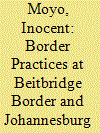

|
|
|
|
|
| Summary/Abstract |
Regarded not only as a line that separates South Africa and Zimbabwe to underline the interiority and exteriority of the two countries, as well as to control and manage migration and immigration, Beitbridge border effectively plays out the immigration debates and dynamics at the heart of the nation-state of South Africa. Based on a qualitative study of how migrants from other African countries are treated at this border and in Johannesburg inner city, we suggest that the harassment suffered by the migrants at the hands of border officials, including immigration officials, the police and army, is indicative of a larger dynamic that exists in the centre, which is represented by Johannesburg inner city. Such bordering and rebordering practices at the border and at the centre reflect negatively on the spirit and letter of the Southern African Development Community (SADC) regional integration project.
|
|
|
|
|
|
|
|
|
|
|
|
|
|
|
|
| 18 |
ID:
114552
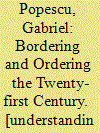

|
|
|
|
|
| Publication |
Lanham, Rowman & Littlefield Publishers, Inc., 2012.
|
| Description |
xi, 183p.Pbk
|
| Standard Number |
9780742556225
|
|
|
|
|
|
|
|
|
|
|
|
Copies: C:1/I:0,R:0,Q:0
Circulation
| Accession# | Call# | Current Location | Status | Policy | Location |
| 056794 | 320.12/POP 056794 | Main | On Shelf | General | |
|
|
|
|
| 19 |
ID:
187440
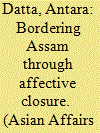

|
|
|
|
|
| Summary/Abstract |
In 1971 when nearly ten million refugees crossed the border between East Pakistan and India following the outbreak of violence in Dacca on 25 March 1971, it would have surprised many to know that nearly fifty years later that date would be the dividing line between India's putative citizens and those it deemed ‘foreigners’. This article takes a look at the immigration debate in Assam, and the protests against the National Register of Citizens and the Citizenship Amendment Act to argue that it is the erasure of 1971 from the latter that gives rise to the backlash against it. I argue that the events of 1971 produces a moment in which both an affective border emerges against the refugees, followed soon after by an effective legal border through citizenship legislation pertinent to Assam. This article investigates the peculiarity of this moment to determine citizenship within India, its consequences and by doing so rewrites the history of 1971 back into debates about citizenship in India.
|
|
|
|
|
|
|
|
|
|
|
|
|
|
|
|
| 20 |
ID:
090162
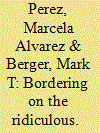

|
|
|
|
|
| Publication |
2009.
|
| Summary/Abstract |
This article examines contemporary concerns about citizenship, security, and development against the backdrop of an emergent "MexAmerica." It seeks to de-routinize the idea of the nation-state and de-naturalize the history of North America in order to move beyond the influential technocratic and quantitative approach to border security and development, and thus to define the current crisis manifested in practices of border security, citizenship, and economic integration.
|
|
|
|
|
|
|
|
|
|
|
|
|
|
|
|
|
|
|
|
|